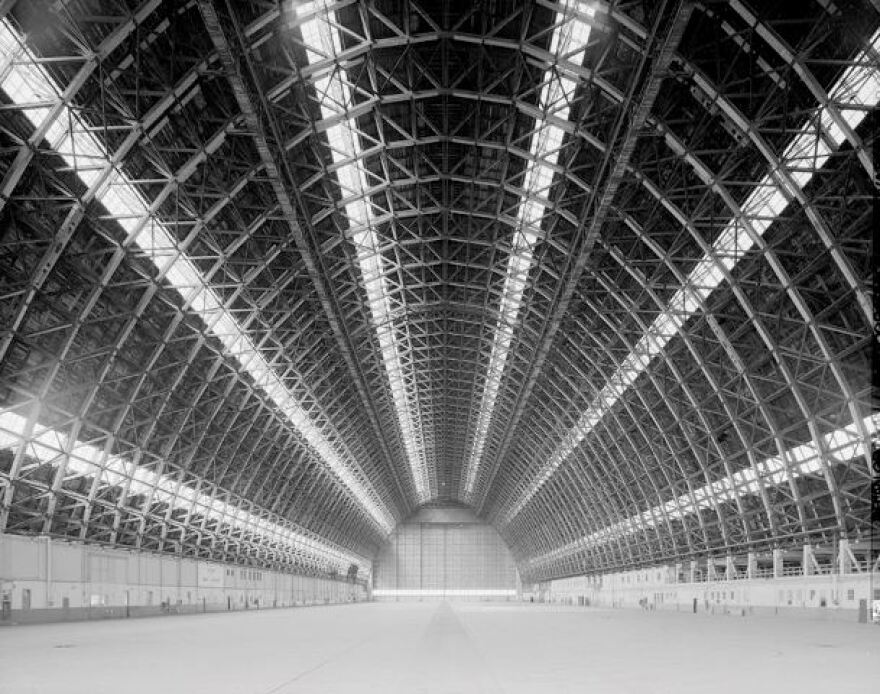Truth matters. Community matters. Your support makes both possible. LAist is one of the few places where news remains independent and free from political and corporate influence. Stand up for truth and for LAist. Make your tax-deductible donation now.
SoCal History: The Significance Of The Tustin Airfield Hangars

Last week, a relic of military history in Orange County and an iconic structure to many local residents went up in flames.
"All of us who have lived in Orange County really in the past four generations...it's just been part of our landscape," historian and Orange County Historical Society President Chris Jepsen said of the World War II era wooden blimp hangar that caught fire early on the morning of Tuesday, Nov. 7.
"You see those hangars and you know you're home," Jepsen said during an interview this week with LAist's AirTalk, which airs daily on 89.3 FM.
A few days after the fire, Orange County declared a state of emergency after smoke and debris from the Tustin hangar fire tested positive for asbestos and other toxins. Schools continue to be closed in the area.
Bastions of coastal defense
Jepsen says the hangars were built in 1942 to house blimps that patrolled the U.S. coastline during World War II.
"The idea was they could keep an eye out for Japanese aircraft, or to some degree submarines coming toward our coast. These hangars, each one could house six large blimps inside it — fully inflated."

At 17 stories high, more than 1,000 feet long, and 300 feet wide, the hangars were two of the largest wooden structures in the world when they were erected in 1942. They were built in a swift six months, as the country was eager to build up protection along its coasts. Jepsen says he's been inside the hangar that is now destroyed, and recalls being awe-struck at its scale.
"It's hard to wrap your brain around what you're seeing when you're in a place like that. It is so enormous."
You see those hangars and you know you're home.
Retired Marine Colonel Brian Delahaut was stationed at Tustin between 1983 and 1995. He told LAist's AirTalk, he remembers being awe-struck the first time he checked into the training squadron at the hangar.
"It was just absolutely incredible...when I checked in in the early 80s, the base was actually called...Marine Corps Air Station Tustin Lighter-than-Air (LTA). We all knew the buildings had been built...for the use of blimps, but the Marine Corps repurposed them and made them into helicopter hangars, so I don't think we appreciate what they were initially built for."
They’ve been mostly vacant since the base was decommissioned in 1999, sometimes serving as a shooting location for films and commercials. The hangars have been featured in television shows and films such as The X Files, Austin Powers, Pearl Harbor, and Star Trek.

Orange County icons
AirTalk and LAist listeners also shared their memories of the hangars.
Listener Jeaniqua in San Diego says she grew up on base housing while her father served in as a helicopter crew chief in the Marines, and even recalls a ballet group she was part of holding a recital inside the hangar.
"It's really sad. We grew up in the shadow of [the hangars] so I have very distinctive and clear memories of the office spaces in there, and even just walking in. The offices were along the side and in the center it was that wide open space, and I remember....just looking up and it seemed like it went up forever."
Listener Tee in Irvine remembers living in an Irvine apartment at Jamboree and Alton and being able to see the hangars from her bedroom window there, and recalls her niece participating in the video for Michael Jackson's song "Hold My Hand" that was shot at the hangars.
"It's just strange that one hangar is now gone. I actually went over...and took pictures. It's unbelievable how basically it looks as if everything has caved in, except for the concrete structures on the end. It's just really sad...it's strange not to have those there because it is a part of the community."
What will be become of the burned hangar?
Local officials have not yet announced plans for what will happen to what remains of the structure, but Jepsen says he'd be surprised if anything is saved or reconstructed, given the condition it's in and some of the environmental concerns about asbestos exposure.
"These things were built in the 40s and some of the materials are cause for concern," said Jepsen.
At the moment, the South Hangar is awaiting environmental remediation before it's handed over from the Navy to the city of Tustin. Jepsen says while a lot of different forms of adaptive reuse have been discussed, there are no concrete plans at the moment.









